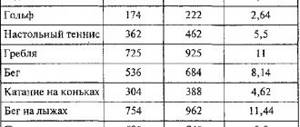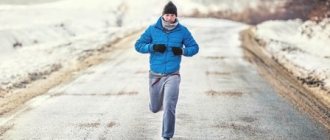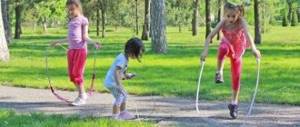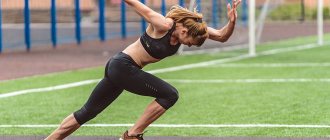Jogging technique
A significant parameter is jogging speed. It cannot be higher than 7 - 8 km/h. The intensity of the respiratory rate remains calm.
The technique is no different from any other type. Landing is on the initial part of the foot, the hip is not carried forward. The body is located at a slight angle. Remember that the incline must be performed with the entire body. Athletes often neglect these rules due to the low tempo of movement. This does not mean a critical error, but it is necessary to know and apply the technique . This significantly reduces the risk of injury. Accordingly, jogging will not cause harm.
What muscles work when jogging?
The heart muscles are strengthened. At the same time, positive changes are observed in the vessels - they become more elastic and durable.
When considering the musculoskeletal system, keep in mind that such a hobby does not provide much stress. This significantly reduces the possibility of injury. However, regularity allows you to significantly strengthen the muscles of the back and front of the thigh, buttocks, and rectus abdominis muscle. Working out these groups not only helps you lose weight, but also gives you a more toned appearance.
Symptoms of body fatigue
If you do more than you need, then your body will become overloaded. At first there will be a positive result, but as the body becomes tired and, especially, as the endocrine system depletes, the positive change in health will fade away, giving way to all sorts of diseases.
A change in your resting heart rate can be a sign of overtraining. It is recommended to measure your pulse every morning before getting up. This is the normal heart rate. If the pulse is 10% higher than usual, then this can be considered a symptom of fatigue. You should reduce the load or rest for a few days.
The reasons for overtraining are too much load and insufficient intervals for the body to recover, conflict situations in the family, at work, especially shift work, sessions, etc. Provoking moments: various infections, systematic violation of the diet, smoking and alcohol abuse, weight loss. There are several phases of overtraining, but the signs are the same, only in a more pronounced form in each subsequent phase.
Signs of Overtraining
The first phase is the cessation of growth in athletic performance, irritability, touchiness, poor sleep, deterioration in health, loss of body weight, and sometimes palpitations occur.
The second phase is a more pronounced decrease in athletic performance, worse adaptation to stress after training, weakness and fatigue. Pain appears in the heart area (a feeling of compression, interruptions), as well as heaviness in the right hypochondrium. The pulse increases in a calm state. Previous diseases worsen and new ones appear.
The third phase is severe apathy, lethargy, weakness, reluctance to engage in usual sports, depression, insomnia at night and drowsiness during the day, profuse sweating, significantly worsening cardiac activity. If these signs appear, stop exercising and consult a doctor.
For running to be beneficial, it should not turn into some kind of test or torture for you, training should bring you pleasure. If you are tired from running, you can ride a bike or go to the pool, or go to the sauna with friends, lie on a massage bed, or just relax.
An indicator of a successfully found temporary training regimen is a gradual improvement in athletic performance. If the results increase, then the selected system is successful. If they stall or fall, then most likely there is a lot of load.
Cycling is an alternative to running.
If you're asking if running alone is worth it, the answer is, of course, no. There are many outdoor games and other sports disciplines, everyone chooses to their liking. But any workout begins with light running, jogging. It was started by Arthur Lydiard.
How to jog correctly for weight loss
It is possible to lose excess weight by jogging. To do this, you need to know some principles.
The pace of jogging must be maintained at a measured pace. The shortest exercise time is an hour to an hour and a half, three times every seven days. Don't forget that the amount of calories burned should be greater than the amount of food consumed. If the diet and quality of food at one meal do not change before and after training, fat will be removed. To calculate energy expended, you need to know how many calories are burned while jogging. The average figure for this indicator is 100 Kcal in ten minutes.
What does jogging do in half an hour?
Most importantly, you get half an hour of pleasure. Jogging burns 300 kcal in 30 minutes. Charges with energy. Helps you relax, unwind, and relieve stress. Improves the nervous, cardiovascular and immune systems.
Contraindications to jogging
Despite all the benefits of jogging, there are contraindications to it. It is not recommended to engage in jogging if you have such diseases as:
- Varicose veins;
- Arthritis;
- Atherosclerosis;
- Heart disease;
- Hypo- and hypertension;
- Glaucoma;
- Flat feet.
Reasons for postponing training may include:
- Sprains and bruises;
- Cold;
- Exacerbation of chronic diseases;
- Recent traumatic brain injury.
Based on the goals of the training, it is worth choosing a suitable training regimen and diet. If increasing physical performance is a priority, jogging should be done over long distances, and nutrition should be nutritious, with a sufficient amount of carbohydrates. The requirements for running for weight loss are the opposite - let's say you have a calorie deficit, but you should forget about the speed and distance of the race. Before you start jogging, you should consult a doctor and, if necessary, undergo a full examination and tests.
The difference between jogging and regular running
The difference between running and jogging is intensity. Regular running burns more kilojoules, but requires more effort from the heart, lungs and muscles.
Important: Running requires a higher level of fitness than jogging.
Both running and jogging are forms of aerobic exercise. The term "aerobic exercise" means any type of physical exercise of relatively low intensity, where oxygen is used as the main source of energy to support muscular motor activity.
Choosing the optimal time for training
It is believed that the best time for jogging is early in the morning. Indeed, exercising in the morning gives a greater fat burning effect. However, the fact that each person has his own specific biological rhythms is often not taken into account.
All people can be divided into two main categories: “larks” and “night owls”. Since the main peak of activity for the former occurs in the early hours, classes from 6:00 to 9:00 are suitable for them. On the other hand, such races can overload the heart, because the body has been at rest all night. Therefore, when waking up, it is important for early risers to do morning exercises. “Owls” are more suitable for jogging from 17:00 to 21:00, when they are most active. About 6-7% of runners completely shift their training to night time.
Setting Goals for Jogging
Think about what you want to get out of jogging. Issues to consider may include:
- Getting in shape . If you are a beginner, you should start with brisk walking, progress to jogging, and aim to progress to regular running. This will take several months.
- General physical preparation . Mix running with other forms of exercise (such as swimming or team sports) to maximize your overall fitness.
- Weight loss . Adjust your diet to include plenty of fresh fruits, vegetables, lean meats, whole grains and low-fat dairy products. Reduce your intake of dietary fat, fast food, sugary drinks and sugar.
What is “Jogging” and how does it differ from other jogging?
Jogging is called jogging according to the Lydiard system.
This is something between regular running and walking. It is also called “shuffling step”. Its main difference is that it is not associated with any officially recognized sport; no special results are expected from it, whereas for other running sports a result - negative or positive - must be expected. “Shuffling step” does not involve participation in any type of competition other than amateur ones.
The main goal of a jogger, unlike track and field athletes, is to maintain the basic rhythm of running. It is important for him not to lose pace and to run the distance to the end. If an athlete feels tired, he can go to a normal walk to take a break, while runners in other sports cannot do this.
Choosing a route to run. While competitive runners must train on trails with specific terrain, for a jogger the terrain is not as important. He can run on any track, be it asphalt, a treadmill at a stadium or a path in the forest.
A goal that regular runners and joggers strive for. The goal of the athletes is to reach the finish line with the highest result. The jogger strives to achieve easy satisfaction.
Training plan for beginners
When starting to train according to the given scheme, keep in mind that only a personal trainer can recommend an exact exercise schedule. Average data shown. Each body is individual, you need to approach sports carefully, listening to yourself. If you have any illnesses, pregnancy, or older people, you should consult a doctor.
Tab. A
| Day of the week | Jogging | Quick step | Number of repetitions |
| Monday | 1 min. | 1 min. | 10 |
| Wednesday | 2 minutes. | 2 minutes. | 5 |
| Saturday | 2 minutes. | 1 min. | 7 |
Tab. B
| Day of the week | Jogging | Quick step | Number of repetitions |
| Monday | 3 min. | 2 minutes. | 5 |
| Wednesday | 4 min. | 2 minutes. | 4 |
| Saturday | 5 minutes. | 2 minutes. | 4 |
Tab. IN
| Day of the week | Jogging | Quick step | Number of repetitions |
| Monday | 7 min. | 3 min. | 3 |
| Wednesday | 10 min. | 3 min. | 2 |
| Saturday | 10 min. | 3 min. | 3 |
Recommendations for beginners to jog
Some general tips for beginners:
- Before starting a running program, see your doctor for a check-up. This is especially important if you are over 40 years old, overweight, have a chronic illness, or have not exercised for a long time.
- Start with a brisk walk. Try to allocate 30 minutes per lesson. Allow at least six weeks to transition to regular running. Aim to increase your jogging time each session and alternate between walking and running.
- Before you start running, warm up properly. When you finish running, do some light stretching.
- Take a water bottle with you on your run. Try to drink plenty of water before, during and after any activity. In our article you can find out how much water you need to drink per day.
- Rest from running at least two full days a week to avoid overtraining, which can cause injury. Engage in other low-impact activities, such as swimming, at least once a week.
- Plan your route. Whenever possible, choose flat, grassy areas rather than hard or loose surfaces (such as sand) to reduce the risk of injury.
- Avoid running near roads. This is especially important if you have a pre-existing condition such as asthma. Car exhaust fumes can increase the risk of various cardiovascular and respiratory diseases.
- Avoid peak periods to reduce the risk of breathing polluted air from cars. If possible, schedule your runs in the early morning or evening.
- Wear loose cotton clothing. If it's cold outside, dress your upper body in several layers so you can remove it as needed.
Choosing running shoes
Issues to consider when choosing running shoes include:
- Don't wear your old sneakers. Bad shoes are a common cause of injury.
- The shoe should bend easily, feel comfortable, and have a wedge of shock-absorbing material in the heel.
- The fit should not be too tight. Your leg will splay out when you hit the ground.
- When buying shoes, wear the socks you plan to wear while running.
Share link:
5 / 5 ( 1 vote)
Clothes for jogging
A properly selected suit plays an important role in the success of training. Running clothing must meet certain requirements:
- Promote body thermoregulation. The fabric should not stick to the body and take a long time to dry, so for running, not natural materials, but synthetic ones, which bring sweat to the surface and allow the skin to breathe, are more suitable;
- Perfect fit. Clothing should not restrict movement or fall off or twist;
- Have reflective elements on the chest and back if you plan to run in the evening or at night.
A jacket is also required for late-hour activities, regardless of the season. In the evening, the air temperature drops sharply, which can lead to a cold if you don't dress warmly enough.
Summer uniform , intended for running in hot weather, should be light and well ventilated. Tops or T-shirts, tights or shorts are suitable as outerwear. Girls also need to purchase sports bras to secure their breasts and protect them from chafing and stretching. In sunny weather, do not forget about a hat and protective skin cream.
The winter uniform should consist of several layers:
- Thermal underwear and gaiters for shin protection;
- Jumper or sweatshirt, pants;
- Jacket with hood, hat, gloves.
At the same time, when going outside in clothes, the athlete should feel cold, and after training it should not be hot. You can also create several sets for different temperatures. In addition, in winter you need to apply a rich cream to your face to avoid chapping.
Compression clothing is also available specifically for runners . Its peculiarity is that it puts pressure on the muscles in certain places. This helps eliminate incorrect leg positioning, reduce pain in the limbs and prevent swelling and venous disease. Such equipment also has good thermoregulation.











